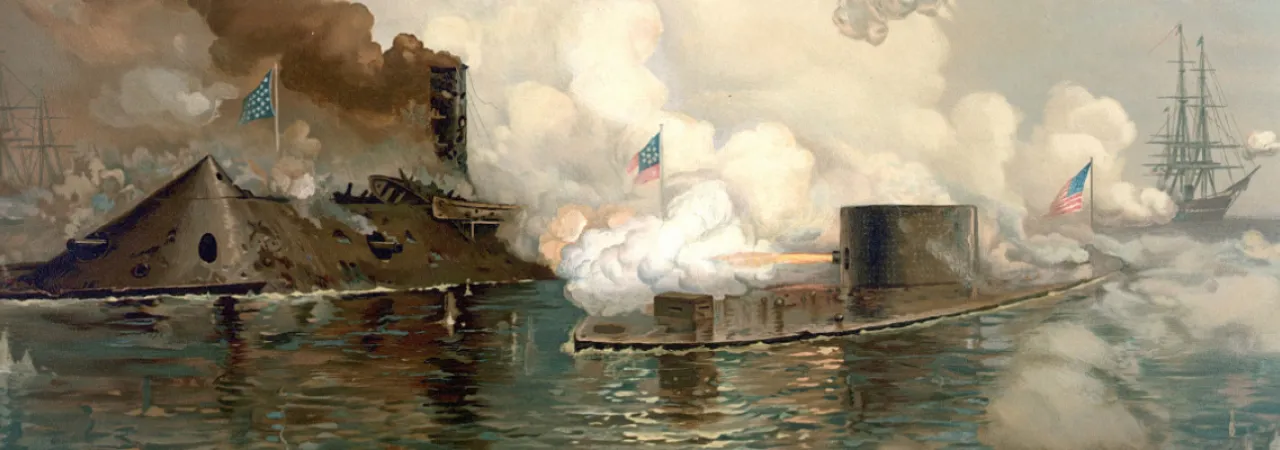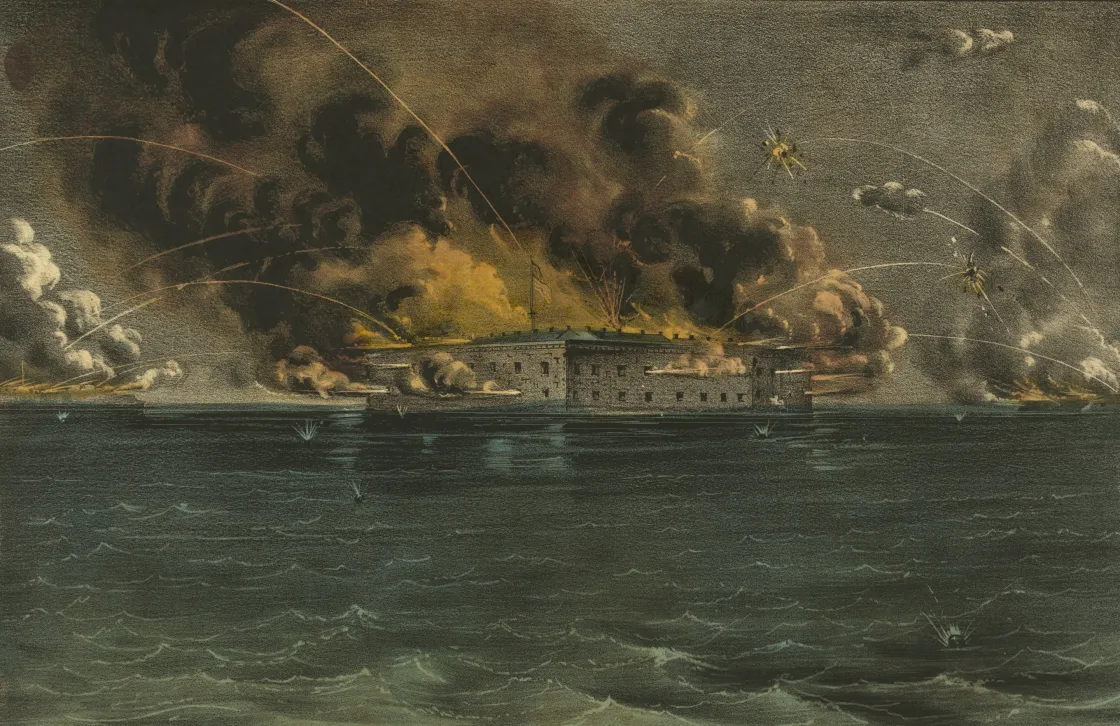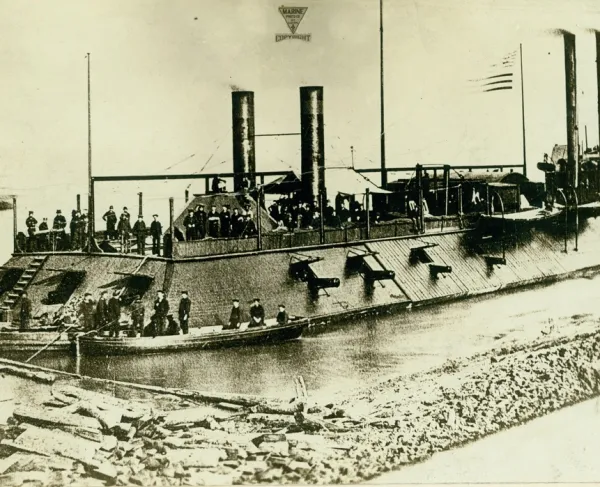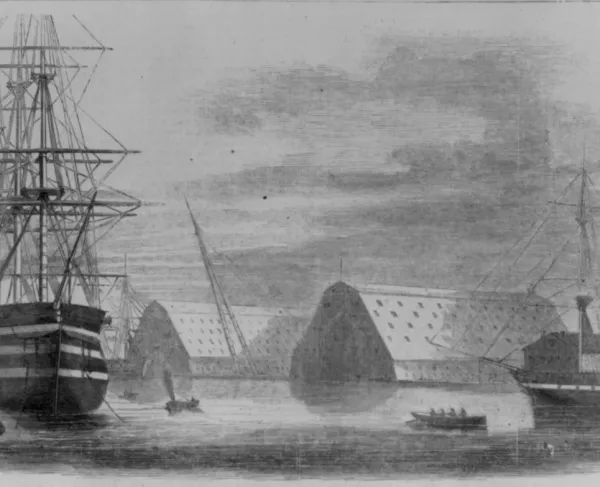
The CSS Virginia, left, sank two wooden-hulled ships before being stopped by the USS Monitor.
At the outset of the Civil War in April of 1861, the Abraham Lincoln administration faced military challenges ashore and afloat. The regular U. S. Army, mustering around 16,000 officers and men, was not large enough and was too spread out across the states and territories to mount a campaign against the new Confederate capital at Richmond. On April 15, two days after the fall of Fort Sumter, Lincoln called for 75,000 new soldiers to suppress the rebelling states. Similarly, the U. S. Navy that April could count less than 50 active warships, spread from Boston to Pensacola and patrolling overseas. Navy Secretary Gideon Welles ordered a crash shipbuilding and acquisition program, and on May 3, Lincoln issued a call for 18,000 new sailors to take the war to sea.

By mid-1861, the Navy had four missions. First, warships were needed to support the new blockade of the Confederate coast by capturing or destroying blockade-running vessels. Second, shallow-draft gunboats were needed on the inland (brown water) rivers to support army operations. Third, Union warships were tasked with destroying Confederate commerce raiders on the high seas. And fourth, Union squadrons were charged with closing port cities and reducing coastal defenses and military facilities. During the war, all these operations were conducted along the Atlantic Ocean coast.
The geography of the coastline was daunting. The blockade declaration covered all ports along the Gulf of Mexico and Atlantic from Texas to South Carolina, some 3,000 miles. After North Carolina and Virginia seceded in May, the blockade was extended another 400 miles north to the Virginia Capes. Large bays, big and deep enough to shelter blockade running ships, cut up the coastline. Hundreds of barrier islands and river inlets where small, fast vessels could find shelter stretched from Key West to Cape Hatteras. The Confederates also occupied many of the massive pre-war forts scattered along the coast, and capturing or destroying those fortifications would be a challenge. Complicating the task was the loss of ships, guns and ammunition abandoned to the Confederates at the Portsmouth, Virginia shipyard on April 20. To carry out their assigned missions, U. S. Navy warships were organized into the Atlantic Blockading Squadron on May 17, 1861. Four months later, the command was divided into the North and South Atlantic Blockading Squadrons, separated at the North and South Carolina border.
Some of the Union’s first victories of the war came on the Atlantic coast. The Confederate government, without seagoing warships like those of the Union, sought to capture vulnerable Northern merchant ships by authorizing the arming of small, fast, privately owned vessels. On July 28, 1861, just a week after the Union loss at Bull Run, the frigate USS St. Lawrence encountered one such “privateer” off the coast of South Carolina. The schooner Petrel, which had been armed with two 32-pound guns, had only been in service 18 days. St. Lawrence chased down the much smaller Petrel, who turned on the big frigate when she came within range. Both ships exchanged fire, but St. Lawrence’s batteries quickly overpowered Petrel and she sank after a quick fight. With few Southern shipowners willing to offer their ships into military service, only some 21 privateers were authorized by the Confederate government, and most were captured by the end of 1862.
Confederate coastal fortifications began to fall that first summer of the war. The defenses on the Outer Banks of North Carolina, where the long, slim barrier islands were linked together by earth and sand forts guarding the navigable passes between them, were the first to surrender. Early on August 28, 1861, North Atlantic Blockading Squadron warships opened fire on hastily built and poorly manned Fort Clark guarding Hatteras Inlet. By mid-day, the Confederates abandoned the fort and withdrew to nearby Fort Hatteras. At dawn the next day, Fort Hatteras was shelled for several hours until it surrendered around noon. Army troops were landed and captured 700 prisoners. With control of Pamlico Sound, Union warships gained access to the mouths of the Neuse and Pamlico Rivers leading deep into the North Carolina interior.
Union victories continued through 1861 as the navy sought an advance base to support the blockade. On November 7, a fleet of 77 warships under Flag Officer Samuel F. DuPont steamed into Port Royal Sound in South Carolina. DuPont’s force was the largest assemblage of U. S. Navy warships up to that time. Forts Walker and Beauregard guarding the harbor were battered into submission by the big warships. The Confederate gunboat CSS Savannah made a stand against DuPont’s fleet but was overwhelmed and withdrew. Some 13,000 Union soldiers were landed after the battle and occupied Beaufort and Hilton Head Island. Further south, in December, Federal troops landed on Tybee Island opposite Fort Pulaski at the mouth of the Savannah River in Georgia. Four months later, Fort Pulaski fell after an artillery bombardment. By the end of 1861, Union forces had gained substantial lodgments along the Confederate coast and had given Abraham Lincoln several well-needed victories.
In early February, 1862, a joint army-navy expedition under Maj. Gen. Ambrose E. Burnside targeted Roanoke Island guarding the entrance to Albemarle Sound. There, 2,500 Confederates in three forts and two batteries surrendered to Union army troops and 19 navy gunboats under Flag Officer Louis M. Goldsborough on February 9. The port towns of Plymouth, Elizabeth City and Edenton quickly fell to the Union. Burnside next turned his attention to the Atlantic & North Carolina Railroad town of New Bern on the Neuse River. Preceded by Cmdr. Stephen C. Rowan’s gunboats shelling Confederate defenders at Fort Thompson, transports with 12,000 soldiers moved up the river and captured the town on March 14. Pivoting 35 miles south, Union army and navy artillery next shelled Fort Macon which surrendered on April 26, along with the towns of Beaufort and Morehead City. Burnside’s victories, the first successful combined operations on the east coast, gave the Union access deep into the heart of North Carolina. Roads and railroads that carried supplies to Confederate armies in Virginia were now vulnerable. Virtually all the North Carolina coast was closed to blockade runners, except for the port at Wilmington. With the neutralization of the Confederate ironclad CSS Virginia by the USS Monitor at Hampton Roads the same week as the victory at New Bern, fortunes for the navy in the region seemed bright.
On March 3, 1862, the new 5-gun gunboat USS Ottawa attached to the South Atlantic Blockading Squadron exchanged gunfire with Fort Clinch and captured Fernandina, Florida at the mouth of the St. Mary’s River. A week later, nearby Jacksonville and St. Augustine fell to Union troops. Florida was the Confederacy’s primary provider of salt, an important meat preservative for army rations, and Union sailors and marines routinely raided salt works along the Florida coast. In one two-month period, navy crews destroyed 290 salt-making facilities. The raids drove up the price of salt and exacerbated the inflation that strangled the Confederate economy. By April, the Union had seized all the Florida and Georgia coastal islands. After the loss of Port Royal, Confederate President Jefferson Davis ordered Gen. Robert E. Lee to take command of the southeast coast. Lee oversaw the withdrawal of valuable infantrymen from the isolated islands, and he directed the improvement of defensive fortifications around Savannah, Georgia.
In early 1863, as Lee had predicted, the Union navy's focus of effort shifted from the North Carolina sounds to the defenses of Savannah and Charleston, South Carolina. (An overview of naval operations conducted around Charleston can be found here). On January 27, the Union monitor USS Montauk and the gunboats Wissahickon, Seneca and Dawn shelled Fort McAllister on the Ogeechee River, 12 miles south of Savannah. They failed to destroy the fortifications, but on February 28 the Montauk sank the blockade runner CSS Nashville which had run aground nearby. Meanwhile, at Savannah, the Confederates had built an ironclad of their own. The CSS Atlanta was a four-gun, casemate ironclad converted from the blockade runner Fingal. On June 17, Atlanta and two wooden gunboats approached the Union monitors USS Weehawken and USS Nahant in Wassaw Sound. As she maneuvered to bring her guns to bear, Atlanta ran aground. The Weehawken pummeled the ironclad with four 11-inch and 15-inch rounds, crushing her pilothouse and gunports. Atlanta was captured after a short fight. Two more ironclads, the CSS Savannah and CSS Georgia were also built at Savannah, but never engaged the Union fleet.
Although hunted by as many as 16 Union warships, Confederate commerce raiders wreaked havoc off the mid-Atlantic and New England coasts. In January, 1863, the British-built CSS Florida under the command of Lt. John N. Maffitt broke through the Union blockade and operated for six months in the Caribbean and western Atlantic taking 37 ships as prizes. One of those captured vessels, the small brig Clarence, now captained by Lt. Charles W. Read from the Florida, took six more ships just outside Hampton Roads. Read then shifted his prize crew to the captured bark Tacony, a larger and faster vessel. Read continued his attacks north up the east coast, capturing 15 more Yankee merchant ships. Read transferred his crew yet again to the small schooner Archer, which he used in an unsuccessful attack on the harbor of Portland, Maine on June 27th. After briefly capturing the Federal revenue cutter Caleb Cushing, Read and his crew were finally taken prisoner.
As 1864 dawned and their army losses mounted, the Confederates sought to reclaim ports in North Carolina close to the Virginia theater. The two-gunned ironclad CSS Albemarle, laid down the year before along the shallows of the Roanoke River 40 miles upstream from Union-held Plymouth, was ready for service. On April 19, Albemarle sortied down the river and attacked the Union defenders at the port. There, she rammed and sank the gunboat USS Southfield and drove off the USS Miami. Two weeks later, three Union gunboats unsuccessfully engaged Albemarle as the Union navy sought to recapture Plymouth. Albemarle’s presence threatened Union-held ports and blockading vessels based in Albemarle Sound. Navy officers approved a daring raid to destroy the ironclad, led by the dashing, young Lt. William B. Cushing. On the night of October 27, Cushing and 15 men in two small boats slipped up the river undetected and approached the Albemarle at her wharf. Rifle fire erupted as Cushing’s men rammed the ironclad below the waterline with a wooden spar torpedo. The explosion sank the Albemarle and several of Cushing’s men were captured. The loss of the ironclad led to the recapture of Plymouth and effectively ended the threat to Union naval operations in coastal North Carolina.
By the end of 1864, Confederate blockade runners on the Atlantic coast were limited to transits from the port of Wilmington, North Carolina. The raiders CSS Chickamauga and CSS Tallahassee broke out of port there and captured or destroyed 40 Yankee merchant ships in three months. Two Union attempts were made to capture Fort Fisher, defending the mouth of the Cape Fear River 17 miles below Wilmington. The first attack on December 24, 1864, was an ill-timed naval bombardment that tipped off the defenders to an army assault, and a Federal ship packed with tons of explosives failed to contact the fort’s defenses and harmlessly blew up at sea. A second attempt was made on January 13, 1865 under Maj. Gen. Alfred Terry and Rear Adm. David D. Porter. Porter’s 58 warships bombarded the fort before Terry’s 12,000 soldiers and marines stormed ashore and established a beachhead. Two days later, a final assault swept the Confederates from their defenses and Wilmington fell a month later. The last Confederate port on the Atlantic was closed, and the flow of supplies from the sea ceased to reach the languishing Confederate armies.
Combat raged up and down the Atlantic Coast and up Confederate held rivers from the beginning of the war to the end. The North and South Atlantic Blockading Squadrons contributed significantly to the ultimate Union victory. Confederate commerce raiders took their toll on Yankee merchant shipping and drew the attention of warships that could have supported the blockade, but, in the end, blockade runners could not transport out enough cotton or return enough weapons and raw materials to tip the balance to the Confederate side. By 1864, Union ironclads and gunboats seemed to be everywhere, all the time, and proved to be better built than their Confederate counterparts. The cooperation between Union army and navy forces was unprecedented in coastal warfare and laid the foundation for modern U. S. Army and Navy victories yet to come.
Further Reading:
- Official Records of the Union and Confederate Navies in the War of the Rebellion, Series 1, Volume 6.
- Commander Will Cushing: Daredevil Hero of the Civil War By: Jamie Malanowski.
- Lincoln and His Admirals By: Craig L. Symonds.
- War on the Waters: The Union and Confederate Navies, 1861-1865. By: James M. McPherson.
- A History of Ironclads By: John V. Quarstein.
- Sea Wolf of the Confederacy: The Daring Naval Raids of Lt. Charles W. Read. By: David W. Shaw.
- Library of Congress Civil War Desk Reference By: Margaret E. Wagner and Gary Gallagher.






